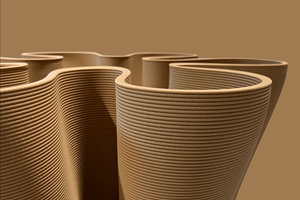Teijin Carbon launches Tenax Next brand, circular carbon fiber
Progress reducing CO2 emissions and advancing circularity is demonstrated through novel filament yarn short fiber carbon fiber options, as well as the launch of a digital product passport.
Tenax Next R2S 513 6-millimeter short carbon fiber. Source | Teijin Carbon
Teijin Carbon (Wuppertal, Germany), a producer of carbon fibers and carbon fiber-based materials, is launching a new brand, Tenax Next, to represent its next-generation carbon fiber products. These feature circular feedstock with significantly reduced carbon footprint while maintaining the strength, durability and performance of traditional Tenax carbon fiber products.
Tenax Next materials are available to industries ranging from aerospace and automotive to pressure vessels and high-quality industrial applications.
“We’ve developed a new generation of materials that meet the growing demand for sustainable solutions,” says Jörg Friedrich, CTO of Teijin Carbon Europe. “And this is just the beginning.”
Along with the brand launch, the company has released two products under the Tenax Next name: Tenax Next HTS45 E23 24K filament yarn and Tenax Next R2S 513.
Tenax Next HTS45 E23 24K is based on Teijin’s high tenacity (HTS) carbon fiber type, known for its optimal processability, heritage and credibility in industrial and aerospace markets. With a tensile strength of more than 4,800 MPa and a modulus of 240 GPa, Tenax Next HTS45 E23 24K provides a high-performance alternative with a 35% reduction in COâ‚‚ emissions compared to existing solutions.
Teijin notes another milestone with this product: The carbon fiber filament yarn is produced using renewable energy, with the option of sustainable raw materials. Additionally, the company is implementing new process technologies to further mitigate environmental impact.
The other product, Tenax NextTM R2S 513, is a 6-millimeter short carbon fiber in rice-shaped form for reinforcing thermoplastic compounds. It is made from repurposed loose fiber materials to achieve environmentally friendly and resource-efficient production. Circular short carbon fiber is suitable for numerous applications across various industries, including sport goods, electronics and automotive vehicles/components.
According to Teijin Carbon, Tenax Next R2S 315 short carbon fiber is targeting several groups, offering customized advantages to each:
- Manufacturers producing or distributing end products made with fiber-reinforced plastics (FRP) can now offer their customers high performance and sustainability. Thanks to full traceability, the lifecycle of the material can be transparently communicated using a digital product passport (DPP), a strong selling point in an increasingly eco-conscious consumer market.
- Component manufacturers and moldmakers working with FRP can benefit from the stability and traceability of the retrieved carbon fiber material, enabling long-term planning, security and reliable quality assurance. The product’s reduced COâ‚‚ footprint also provides an advantage where an environmental product declaration is required.
- Compounders producing thermoplastic compound pellets from fiber-reinforced commodity plastics and thermoplastics can rely on a stable supply of raw materials and consistent pricing. This reduces procurement risks and strengthens the company’s environmentally friendly profile.
Teijin Carbon has established its carbon fiber production and supply system based on ISCC Plus certification. For example, the company uses various chemical building blocks to produce polyacrylonitrile. While conventional and sustainable raw materials can be purchased on the global market, in the future Teijin Carbon intends to purchase more materials obtained through recycling or directly from bio-based sources.
Teijin has also launched its first digital product passport (DPP), a datasheet that, accessed via QR code, ensures full transparency and traceability throughout the entire product life cycle. It provides detailed information about the product’s origins, materials and sustainability, from production to end of life.
Related Content
Infinite Composites: Type V tanks for space, hydrogen, automotive and more
After a decade of proving its linerless, weight-saving composite tanks with NASA and more than 30 aerospace companies, this CryoSphere pioneer is scaling for growth in commercial space and sustainable transportation on Earth.
Read MoreSulapac introduces Sulapac Flow 1.7 to replace PLA, ABS and PP in FDM, FGF
Available as filament and granules for extrusion, new wood composite matches properties yet is compostable, eliminates microplastics and reduces carbon footprint.
Read MoreLow-cost, efficient CFRP anisogrid lattice structures
CIRA uses patented parallel winding, dry fiber, silicone tooling and resin infusion to cut labor for lightweight, heavily loaded space applications.
Read MoreJEC World 2024 highlights: Thermoplastic composites, CMC and novel processes
CW senior technical editor Ginger Gardiner discusses some of the developments and demonstrators shown at the industry’s largest composites exhibition and conference.
Read MoreRead Next
Circularise digital passports contribute to PU foam recycling
Under the Circular Foam initiative creating systematic approaches for efficient rigid polyurethane (PU) foam recycling, Circularise’s DPPs are advancing secure information traceability for recycling and consumers.
Read MoreTeijin Carbon introduces 36K intermediate modulus carbon fiber
High-tensile, high-performance material option is well-suited for demanding applications like pressure vessels.
Read MoreUltrasonic welding for in-space manufacturing of CFRTP
Agile Ultrasonics and NASA trial robotic-compatible carbon fiber-reinforced thermoplastic ultrasonic welding technology for space structures.
Read More












